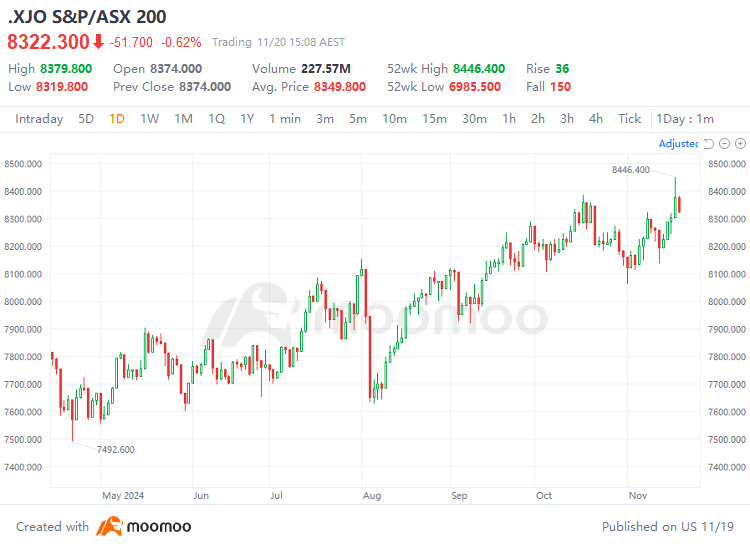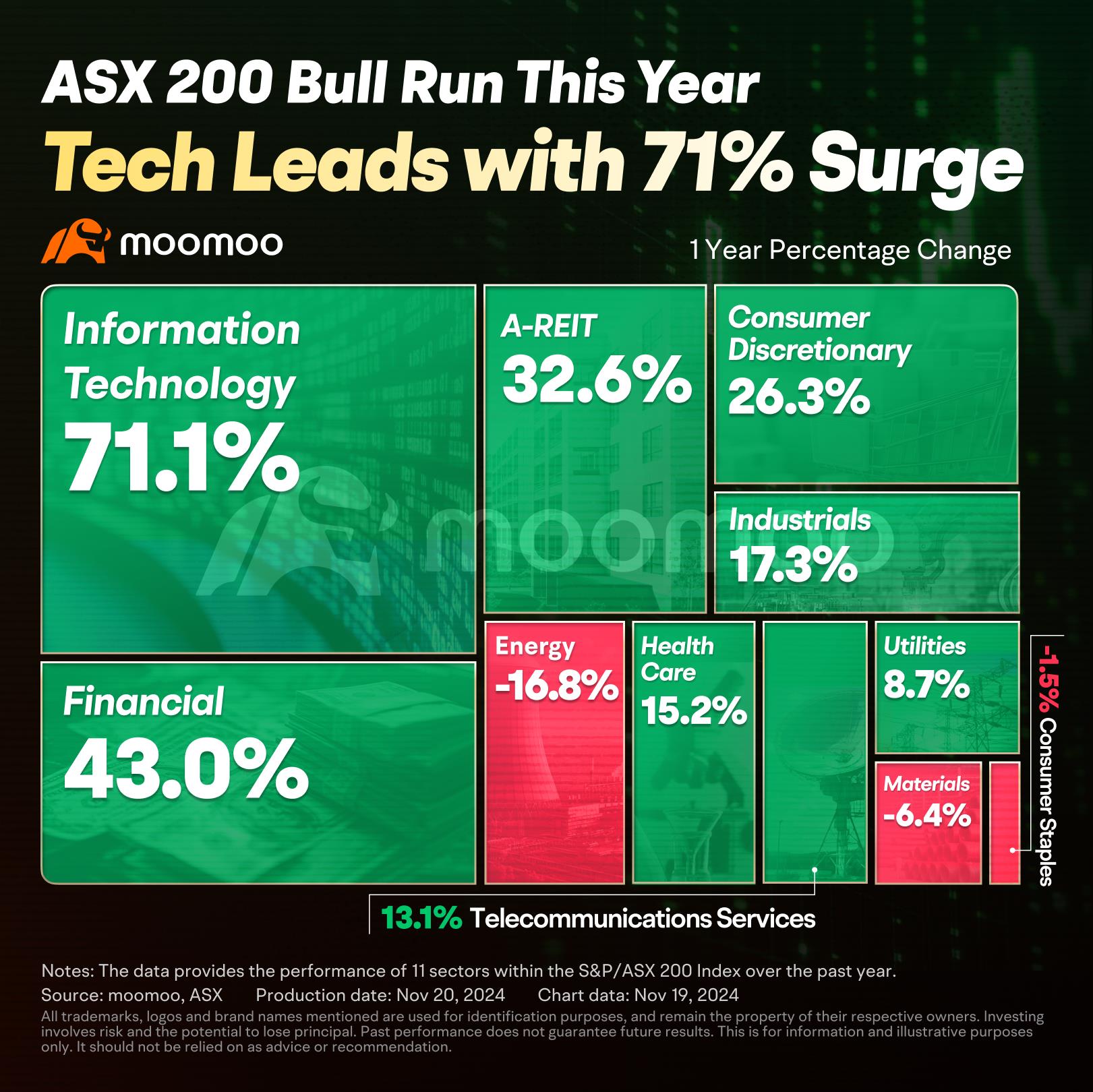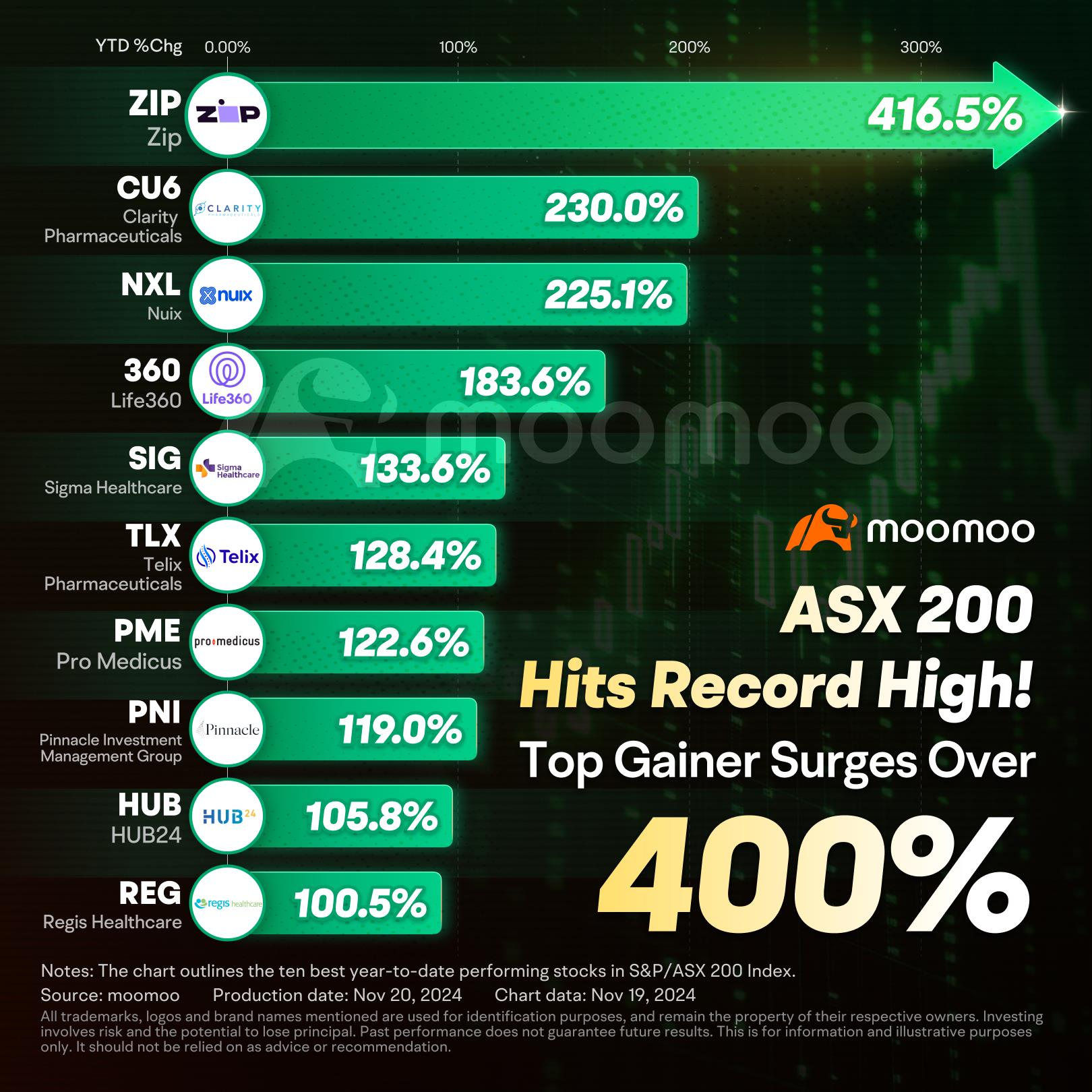ASX 200 hits a new record high: Key points for investors to watch
$S&P/ASX 200 (.XJO.AU)$ reached a record high on Tuesday, closing at 8,374 points and touching an intraday peak of 8,446 points. As of November 19, the ASX 200 index has risen by 2.6% this month, surpassing the typical November increase. In comparison, the average gain for November over the past 20 years is 0.5%, and the average increase over the last decade is 1.8%.

ASX200 jumped 10.32% YTD as of November 19's close
ASX 200 surged 66.53% from its low of 4,402.5 points during the COVID-19 outbreak in 2020. Top broker Morgan Stanley saw further upside for the benchmark index, having raised its year-end forecast to 8,500 points.
The financial sector holds a significant position in the S&P/ASX 200, with Australia's four major banks— $CommBank (CBA.AU)$, $National Australia Bank Ltd (NAB.AU)$, $Westpac Banking Corp (WBC.AU)$, and $ANZ Group Holdings Ltd (ANZ.AU)$—being the representatives.
The materials sector, particularly mining companies such as BHP and Rio Tinto, is also a crucial component of the index. As a leading global exporter of mineral resources, Australia's mining companies have a highly influential position in the global mineral market. Other industries like energy companies such a $Woodside Petroleum Ltd (WPL.AU)$ and healthcare giants such as $CSL Ltd (CSL.AU)$ also occupy important positions in the index .
Over the past 12 months, the ASX 200 climbed approximately 17%, with 8 out of 11 sectors showing growth. Among them, Information Technology, Financial, and A-REIT sectors stood out, boasting increases of 71.1%, 43.0%, and 32.6% respectively.

In terms of individual stocks, Zip shares soared over 416% year-to-date, leading the index. Following closely behind are CU6 and NXL, with the top ten performers accumulating returns of over 100%.

Factors driving the Australian stock market upward
1. Australia's Economic Performance
Australia's labor market has outperformed other countries, with the unemployment rate decreasing by 0.1% in September and remaining unchanged at 4.1% in October. The employment rate in September was 67.2%, a slight increase of 0.1%, and in October it was 67.1%, a slight decrease of 0.1%. The robust job market has provided significant support for the economy.
Inflation remained stable with a 2.1% year-on-year increase in the CPI in September. Regarding interest rate adjustments, RBA decided to keep the official cash rate unchanged at 4.35% in its latest announcement, a level that has remained constant since the last rate hike in November 2023. Despite inflation gradually rising to the RBA's target range of 2% to 3%, the RBA's stance remains firm.
2. The Stimulating Effect of the Robust U.S. Stock Market Performance
Year to date, the Nasdaq has risen over 26%, the S&P 500 has increased over 24%, and the Dow Jones has climbed over 14%. The strong performance of U.S. stocks are connected to the U.S. economy, where the labor market has performed much better than anticipated, and inflation seems to be under control.
Particularly during the U.S. election period and with Trump's return to the White House, the "Trump trade" has propelled U.S. stocks to new heights. The market widely believes that Trump's policies will be beneficial for U.S. stocks. Trump's plan to reduce the corporate tax rate from 21% to 15% could directly boost corporate profits, which in turn would be favorable for the U.S. stock market. The optimistic sentiment in U.S. stocks is also likely to spread to the Australian stock market, providing a certain stimulus to the performance of the Australian equities market.
3. The Impact of China's Economic Stimulus Measures
China's recent announcement of a comprehensive package of economic stimulus measures has exceeded expectations, particularly in the realm of monetary policy. This significant shift towards proactive policies has ignited confidence and optimism in the recovery of the Chinese economy, subsequently driving an increase in Australian mining and resource stocks.
Given the close trade ties between Australia and China, China's economic growth can increase demand for Australian export goods, thereby propelling the share prices of related Australian energy and materials sectors upward. Additionally, China's fiscal stimulus plan has boosted market sentiment, which in turn positively affects the Australian stock market.
Australian Stock Market Outlook
As a key participant in the global commodity and energy markets, Australia's economy is heavily dependent on the performance of its mineral and energy exports. China's economic growth and demand for resources have a significant impact on the Australian stock market. It is important to continuously monitor the implementation of China's economic stimulus policies and the recovery of its economy, as these will have a more direct impact on the Australian economy and stock market.
Since Australia is one of the world's major resource exporters, mining and energy companies hold an important position in the S&P/ASX 200. Therefore, global commodity prices, especially for iron ore, coal, and natural gas, have a direct and significant impact on the index's value. For instance, an increase in iron ore prices typically indicates stronger profitability for mining giants like BHP and Rio Tinto, thereby driving up their stock prices. Conversely, a decline in global commodity prices may undermine market confidence in mining and energy companies.

Source:ASX, Bloomberg
Disclaimer: Moomoo Technologies Inc. is providing this content for information and educational use only.
Read more
Comment
Sign in to post a comment
